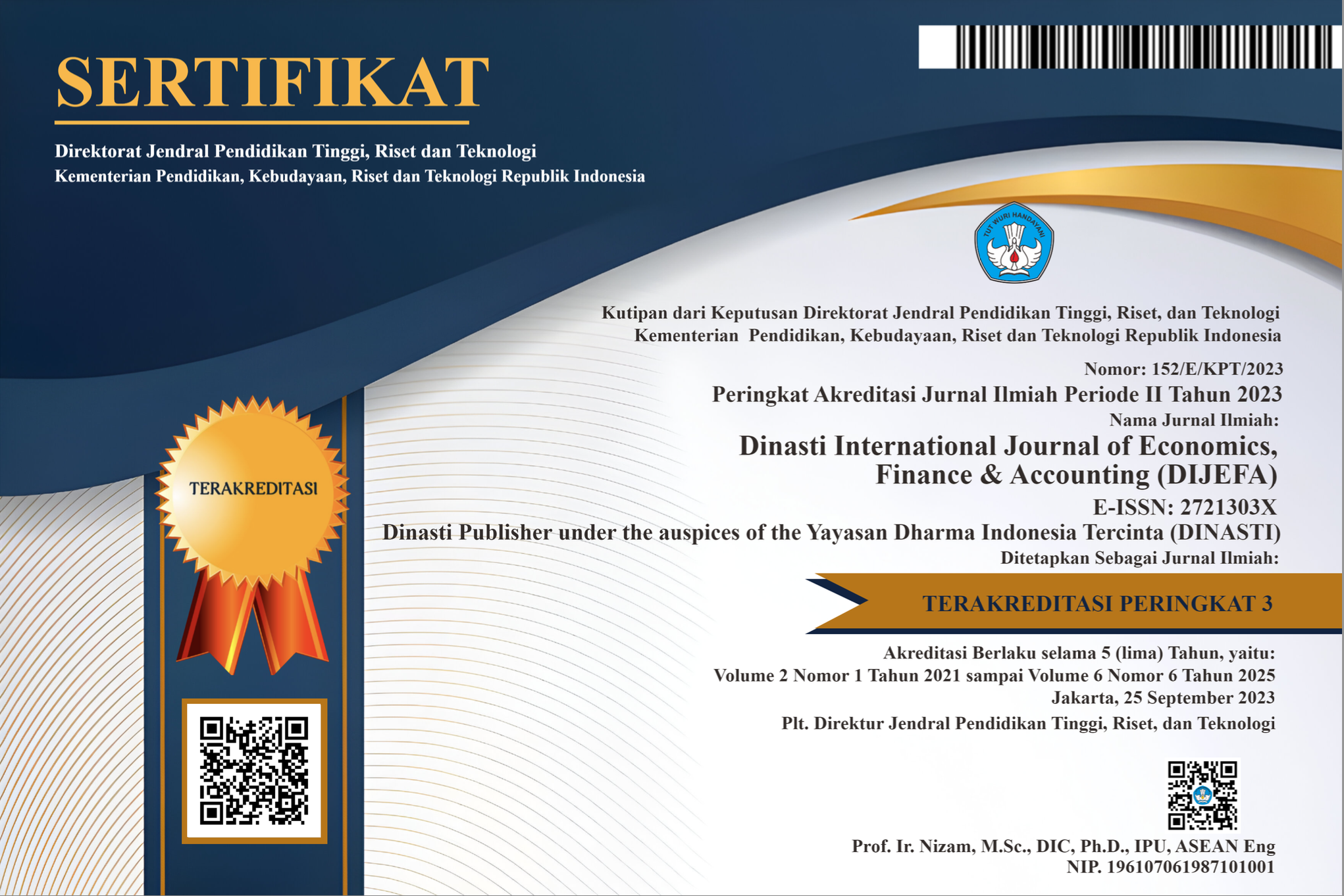Dynamic Analysis of the Relationship Between Market Sentiment and Stock Volatility at the Bei Using the Auto Regressive Integrated Moving Average (ARIMA) Model
DOI:
https://doi.org/10.38035/dijefa.v6i2.4400Keywords:
ARIMA Model, Market Sentiment, Stock VolatilityAbstract
This study aims to analyse the dynamic relationship between market sentiment and stock volatility on the Indonesia Stock Exchange (IDX) using the Autoregressive Integrated Moving Average (ARIMA) model. The research method used is a quantitative method with a causality approach using secondary data in the form of time series data of quarterly financial reports of PT Adhi Karya for the period 2008-2023, which is analysed through the ARIMA model for forecasting and selecting the best model based on statistical criteria. The ARIMA (1, 1, 1) model effectively represents the historical data pattern of quarterly assets of PT United Tractor with a stable trend and a slight gradual increase for the period December 2024 to December 2026. However, this model has limitations in capturing more complex variations or dynamics in the data. Accurate ARIMA models help maintain financial market stability, support efficient investment decision-making, and provide insights for macroeconomic policy planning that drives economic growth. In addition, reliable predictions increase investor confidence, both domestic and foreign, thereby strengthening financial sector risk management and encouraging investment for sustainable economic development.
References
Allende, H., Ulloa, G., & Allende-Cid, H. (2015). Prediction intervals in linear and nonlinear time series with sieve bootstrap methodology. In Advanced Studies in Theoretical and Applied Econometrics. https://doi.org/10.1007/978-3-319-03122-4_16
Anhar, M., Maronrong, R., Burda, A., & Sumail, L. O. (2024). Dynamics of Indonesian stock market interconnection: Insights from selected ASEAN countries and global players during and after the COVID-19 pandemic. Investment Management and Financial Innovations, 21(2), 180–190. https://doi.org/10.21511/imfi.21(2).2024.14
Asadi, S., Tavakoli, A., & Hejazi, S. R. (2012). A new hybrid for improvement of auto-regressive integrated moving average models applying particle swarm optimization. Expert Systems with Applications. https://doi.org/10.1016/j.eswa.2011.11.002
Bogusz, J. (2015). Geodetic aspects of GPS permanent station non-linearity studies. Acta Geodynamica et Geomaterialia. https://doi.org/10.13168/AGG.2015.0033
Bursa Efek Indonesia. (2022). Statistik pasar modal: Indeks Harga Saham Gabungan (IHSG) dan kapitalisasi pasar. Diakses dari https://www.idx.co.id.
Chen, S. T., & Haga, K. Y. A. (2021). Using E-GARCH to Analyze the Impact of Investor Sentiment on Stock Returns Near Stock Market Crashes. Frontiers in Psychology. https://doi.org/10.3389/fpsyg.2021.664849
Dai, Z. M., & Yang, D. C. (2018). Positive Feedback Trading and Investor Sentiment. Emerging Markets Finance and Trade. https://doi.org/10.1080/1540496X.2018.1469003
Imfrianti Augtiah, Saefudin Saefudin, & Sujatmiko Sujatmiko. (2024). Financial literacy improvement strategy to encourage fintech adoption and MSMEs performance in Karanganyar Regency. World Journal of Advanced Research and Reviews, 22(3), 1109–1116. https://doi.org/10.30574/wjarr.2024.22.3.1807
Karia, A. A., Hakim, T. A., & Bujang, I. (2016). World edible oil prices prediction: Evidence from mix effect of ever difference on Box-Jenkins approach. Journal of Business and Retail Management Research.
Kontopoulou, V. I., Panagopoulos, A. D., Kakkos, I., & Matsopoulos, G. K. (2023). A Review of ARIMA vs. Machine Learning Approaches for Time Series Forecasting in Data Driven Networks. In Future Internet. https://doi.org/10.3390/fi15080255
Kumala, I. W., Saefudin, S., & Adibatunabillah, S. R. (2023). Pemodelan Loyalitas Pengguna Aplikasi Ovo Di Kota Malang: Peran Kualitas Layanan Dan Citra Merek Dengan Kepuasan Sebagai Pemediasi. Jurnal MD: Jurnal Manajemen Dakwah UIN Sunan Kalijaga Yogyakarta, 09(1), 132–154.
Lee, T. (2022). Wild bootstrap Ljung–Box test for residuals of ARMA models robust to variance change. Journal of the Korean Statistical Society. https://doi.org/10.1007/s42952-022-00172-6
Lim, Y., & Kim, K. T. (2019). Afraid of the stock market. Review of Quantitative Finance and Accounting. https://doi.org/10.1007/s11156-018-0766-x
Qi, Y., Li, H., Liu, N., Hao, X., & Guan, Q. (2018). Transmission characteristics of investor sentiment for energy stocks from the perspective of a complex network. Journal of Statistical Mechanics: Theory and Experiment. https://doi.org/10.1088/1742-5468/aac916
Rivera, J. P. R. (2015). The role of stationarity in business and economic research. Journal of Economics and Economic Education Research.
Rohman, M. A. F., & Saefudin. (2024). Determinant Factors in Stock Returns of Food and Beverage Industry Companies in Indonesia. Journal of Management Studies and Development, 3(01), 42–55. https://doi.org/10.56741/jmsd.v3i01.448
Ryu, D., Kim, H., & Yang, H. (2017). Investor sentiment, trading behavior and stock returns. Applied Economics Letters. https://doi.org/10.1080/13504851.2016.1231890
Suhermi, N., Suhartono, Prastyo, D. D., & Ali, B. (2018). Roll motion prediction using a hybrid deep learning and ARIMA model. Procedia Computer Science. https://doi.org/10.1016/j.procs.2018.10.526
W. A. Nanlohy, Y. (2021). Autoregressive Integrated Moving Average (ARIMA). Tensor.
Wijesinghe, G. W. R. I., & Rathnayaka, R. M. K. T. (2020). Stock market price forecasting using ARIMA vs ANN; A Case study from CSE. ICAC 2020 - 2nd International Conference on Advancements in Computing, Proceedings. https://doi.org/10.1109/ICAC51239.2020.9357288
Yaziz, S. R., Azizan, N. A., Zakaria, R., & Ahmad, M. H. (2013). The performance of hybrid ARIMA-GARCH modeling in forecasting gold price. Proceedings - 20th International Congress on Modelling and Simulation, MODSIM 2013. https://doi.org/10.36334/modsim.2013.f2.yaziz
Zuo, X. (2019). Several Important Unit Root Tests. 2019 2nd IEEE International Conference on Information Communication and Signal Processing, ICICSP 2019. https://doi.org/10.1109/ICICSP48821.2019.8958557
Downloads
Published
How to Cite
Issue
Section
License
Copyright (c) 2025 Hariyanti, Rokhadi, Vena Vilenia

This work is licensed under a Creative Commons Attribution 4.0 International License.
Authors who publish their manuscripts in this journal agree to the following conditions:
- The copyright on each article belongs to the author(s).
- The author acknowledges that the Dinasti International Journal of Economics, Finance & Accounting (DIJEFA) has the right to be the first to publish with a Creative Commons Attribution 4.0 International license (Attribution 4.0 International (CC BY 4.0).
- Authors can submit articles separately, arrange for the non-exclusive distribution of manuscripts that have been published in this journal into other versions (e.g., sent to the author's institutional repository, publication into books, etc.), by acknowledging that the manuscript has been published for the first time in the Dinasti International Journal of Economics, Finance & Accounting (DIJEFA).


























































